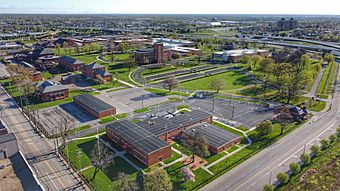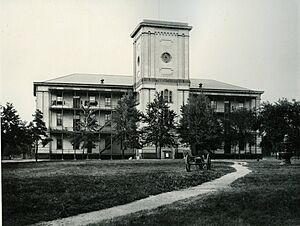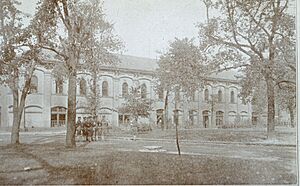Fort Hayes facts for kids
Quick facts for kids |
|
|
Fort Hayes
|
|
 |
|
| Location | Columbus, Ohio |
|---|---|
| Built | 1863 |
| Architect | T.C. Bradford |
| Architectural style | Renaissance |
| NRHP reference No. | 70000491 |
| Added to NRHP | January 26, 1970 |
Fort Hayes was once a very important military base in Columbus, Ohio, United States. It was started by the United States Congress in 1862. For a long time, it was known as the Columbus Arsenal. In 1922, its name changed to Fort Hayes. This was to honor Rutherford B. Hayes, who was an Ohio Governor and later the 19th President of the United States.
Since 2007, most of the land has been used by the Columbus School District. It is home to the Fort Hayes Metropolitan Education Center and a bus depot. The last military groups, like the 391st Military Police Battalion, left in 2009. The army built a new center in Whitehall, ending a long military history at Fort Hayes.
Contents
History of Fort Hayes
Fort Hayes was a military post for many years. It started in 1863 and the last soldiers left by the end of 2009. Let's learn about its journey through time.
The Columbus Arsenal Years
The army needed a safe place to store weapons and supplies. In 1862, during the American Civil War, the old state arsenal was not safe. It was also a fire risk. So, the army decided to build a new, modern arsenal.
In 1863, a good spot was chosen. It was about 70 acres of land with oak trees. Captain J. W. Todd was the first leader of the Columbus Arsenal. When he arrived, the site was just a field of tree stumps and small temporary shelters.
Captain Todd made the first plan for the arsenal. He wanted to build workshops, storehouses, and living areas for soldiers. He also planned for an office, officer's homes, and a strong brick wall. A railroad track was also needed to bring in supplies.
Captain Todd did not stay long enough to see his plan built. Captain T. C. Bradford took over in January 1864. He is known as the "Father" of Fort Hayes. Bradford was in charge of building the new post from the very beginning.
His first job was to get the railroad track finished. He also needed carts, horses, and tools for building. By April 1864, the ground was ready. Temporary shops were built, and wells were dug for water.
Bradford called his main building the "Store House." He made many changes to the plans as they built it. Getting building materials was hard and costly back then. Sandstone for the foundation came from Newark, Ohio by train. Bricks were made in Columbus. Wood came from southern Ohio.
The officers' homes and a large magazine (for storing gunpowder) were also ordered. The magazine could hold 2,500 barrels of powder.
Even before the main building was finished in 1865, the post was busy. It was receiving and sending out many weapons. For example, in May 1864, it sent out two million bullet cartridges. It also had enough weapons to arm 30,000 men.
The first building, known as Building #62, was finished in 1864. By late 1864, the large main building was being used. Sadly, the first person killed at the post was a civilian. Nicholas Kaetzel died in 1865 while firing a salute.
After the war, the arsenal continued to be busy. It received many weapons from soldiers returning home. Civilian workers repaired rifles. If a weapon could be fixed for a small cost, it was. If not, only the good parts were saved.
By November 1865, the magazine was full. The main building's basement was then used to store ammunition. Ten thousand new Spencer carbines (a type of rifle) were stored upstairs. The post also started selling extra military items. In 1875, the Columbus arsenal was changed. It became a place for recruiting soldiers. It was then called Columbus Barracks.
Columbus Barracks and Fort Hayes
In 1875, the United States Department of War changed the base's purpose. It became a place where new soldiers were brought in and trained. It was first known as Columbus Barracks. Later, in 1922, it was renamed Fort Hayes. This was done to honor Rutherford B. Hayes.
Between 1875 and 1890, Columbus Barracks trained many different types of recruits. This included young musicians and new soldiers. Recruits received special training that lasted from one to four months. In 1894, the 17th Infantry Regiment was stationed there.
During the Spanish–American War, the base grew bigger. The main arsenal building was changed to hold 500 recruits. New barracks (soldier homes), officers' houses, and other buildings were built. These included a reception center and a drill hall. A newspaper for the post, The Army Herald, also started in 1895.
In 1900, the post got nearly 8 more acres of land. Five years later, it became the official Columbus Recruiting Depot. A military band was assigned to the post in 1906. Their concerts became popular public events.
Electricity came to the depot in 1908. With it, new buildings were added. These included a hospital, a store (PX), a gym, and new homes for officers and non-commissioned officers. A bakery, a laundry, a warehouse, and more barracks were also built.
When World War I began in 1917, Fort Hayes became very busy. It was a major center for new army recruits. After the war, in 1922, the post became the main office for the Fifth Corps Area. This area included Ohio, West Virginia, Indiana, and Kentucky.
In 1933, the current parade grounds were built. The Civilian Conservation Corps also built seven new wooden buildings.
During the early years of World War II, Fort Hayes continued as a reception center. About 2,000 officers and men were stationed there. But this role ended on March 1, 1944. On December 17, 1946, the Ohio National Guard was allowed to use the post. It continued to be used by both state and federal governments for military and civilian purposes.
Fort Hayes Metropolitan Education Center
The Fort Hayes Metropolitan Education Center (FHMEC) is a public high school in downtown Columbus. Its goal is to help students achieve great things. It does this by combining arts, school subjects, and career programs.
The Fort Hayes Career Center started in 1976 on part of the old military base. After the Vietnam War, the government no longer needed 50 acres of the base. The Columbus Public Schools were able to buy this land for just one dollar.
The career center first had four buildings. These were for business, health, visual arts, and math/science. In 1988, the Fort Hayes campus became home to three special programs. These were a career center, a science program for young people, and an arts and academic high school.
The career center offers classes in health, data processing, art, photography, and performing arts. The science program provides advanced math and science courses. The Fort Hayes Arts and Academic High School focuses on strong college prep and deep learning in music, dance, theater, and visual arts.
The Fort Hayes Arts and Academic High School started in the 1988–89 school year. It joined other great programs in Columbus Public Schools. The first group of seniors graduated in June 1991.
The school has been recognized many times for its excellence. Redbook magazine called it an outstanding school. Business Week magazine praised it for its new ways of teaching with an arts-focused plan. In 1997–98, it was named the Outstanding School by a group of arts schools.
FHMEC is a diverse school. About 51% of students are African-American, 47% are Caucasian, and nearly 4% are Asian-American. Most students (63%) are female. Students come from many different backgrounds and beliefs. About 30% of students are from low-income homes. Over 1100 students, 80 teachers, and five leaders are on campus each school day.



